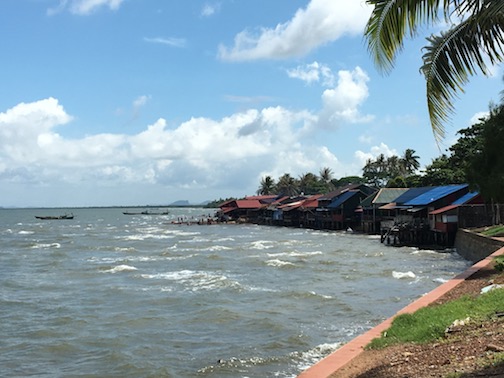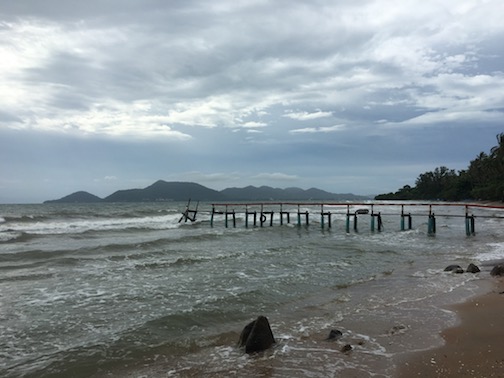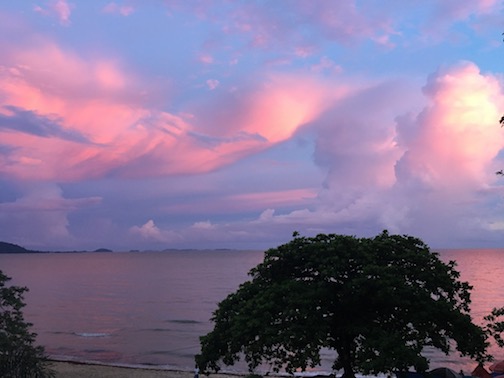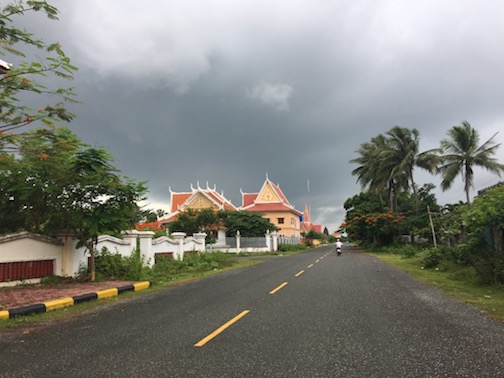Week 3: Kep, Adaptation & Data
We took the weekend as an opportunity to get out of Phnom Penh and see more of Cambodia. We bussed to Kep, which is typically supposed to be a four-hour trip. Sunday, however, were the communal elections and Friday was the last day for the parties to campaign. Unfortunately for us, that meant stand-still traffic in the city as we were trying to get out. It took us about an hour to go one block. Once outside the city, the ride flew by.
The rate of our progress accelerated once we hit the highway, primarily due to the fact that the bus drivers drive like bullies: flashing high beams, honking aggressively, and passing anything that is smaller and/or slower than they are, even if that means forcing others onto the shoulder or near misses with on-coming traffic. (It’s usually best not to watch or pay attention to that.) This ride was not a far cry from those that I’ve experienced in Ecuador and Guatemala; despite the wild driving, I actually enjoy bus rides. From point A to point B, I don’t have to be “on,” like life abroad often demands. I can be a passive observer, watching the Cambodian landscape float past. I can see the low laying, flooded rice paddies and their workers, contrasted by the drama of the tall palm trees and distant green mountains. I can see families on motos with children or elderly sandwiched between the adults. I can see bony cattle, water buffalo, stray dogs playing, roaming roosters, and cats. Futbol games in the fields; volleyball games in the yards. Swinging hammocks. Stilted homes. Line-drying laundry. Large concrete earns collecting and storing water. Dramatic skies. Piles of trash, some of which are smoldering after attempts to incinerate them. Road-side vendors selling fruit and the less-appealing-hanging slabs of meat. Statues of Buddha. Overcrowded vans with cargo, or even people, spilling out, accommodated only by the metal rack extending from the bumper and the back hatch forced open and tied down to the rack. As light and visibility wanes, I see the blur of passing motos, cars, trucks, and the illuminated roadside homes and businesses.
Kep was a welcomed change of pace from Phnom Penh. The sea breeze with just a hint of cool air was refreshing. As was the quiet and stillness that came with a lack of traffic. Kep has the nicest smelling fish market I’ve ever been to. Seriously. Their crab market is famous and well worth the visit! It’s not huge, but has a lot to offer: several kinds of fish, crab, shrimps, squid, octopus, sting ray, and of course all the fruits, veggies, and other typical market fare. It’s right along the ocean so the breeze keeps the air moving and the vendors cook up a lot of the seafood right there so the burning wood, fire, and cooked food smelled great. We also took a boat to Koh Tonsay (Rabbit Island). It was a stormy afternoon, which made for an exciting boat ride. Sunday we rented motos and explored the countryside around Kep until the monsoon thunderstorm hit and forced us off the road.
Since my last post I’ve: researched and written the draft of the Adaptation page; spent a considerable amount of time hunting for data sets; started researching and began the draft of the Mitigation page. For the Adaptation page, I had to learn about the international structure, which hinges upon The United Nations Framework Convention on Climate Change (UNFCCC), the Paris Agreement, and National Communications. Of course, with the US Federal Government’s withdrawal from the Paris Agreement last week, I’m sure everyone has been learning more about it! The news was certainly relevant to my research.
As for the data, I started looking at sets available through the UN. The Sustainable Development Goals (SDGs) that the UN recently organized have a lot of overlap with climate change, and one addresses climate change directly. Therefore, the SDGs have many indicators that are relevant to, climate change. However, the SDGs are so new, that there have not been many studies or data sets produced yet. So, I had to dig a little deeper to see what else was there. But I must say, it is rewarding to find just the right set that contains the information you’re looking for and complements the material you’re want it to. The next phase of deciding which sets are the best fit, how to incorporate them, and creating the data visualizations, will be a challenging process. Just today I spent my first ten minutes or so “playing” with DataWrapper; I have a lot to learn! It will be a satisfying process to edit the data and create the visualization that best represents the data.
With the Mitigation page, I’m learning about Nationally Appropriate Mitigation Actions (NAMAs), the Clean Development Mechanism (CDM), and the UN’s program on Reducing Emissions from Deforestation and Forest Degradation (REDD+). Once I finish researching and writing my Mitigation draft, in addition to all of the editing and finalizing that will follow, I’ll likely be tasked with updating the Land topic pages on the Open Development Vietnam page. More on that assignment when I get there!






